First Looks: New V10 v V14
 New V10 v V14!
Credits: Erik Borgnes
New V10 v V14!
Credits: Erik Borgnes
[Editor: Author Erik Borgnes recently took delivery of two of Epic Kayaks latest surfskis: a V14 in the Ultra layup and a "New V10" in the sexy black Elite layup. I asked him to give us his impressions of the new skis - it's a great read!]
Know this: I'm a member of Epic's regional racing team and I'm partial to how Epic's skis fit and perform. Although I have paddled and owned Fenns and Thinks in the past, my intention in this article is not to make a comparison between brands but to introduce and parse out the differences between two of Epic’s latest offerings.
The V14 - I think I’m going to need a bigger paddle
Epic’s new V14, which took 3 of the top 5 places in the 2013 Molokai, has already proven that it is a competitive ski. This new design by Greg Barton and Oscar Chalupsky is 1% to 1.5% faster than the new V10 in Epic’s in-house speed tests, with the V12 being somewhere in between. A quick back of the hand calculation then puts the V14 at about 0.1 or 0.15 mph (0.16 or 0.24 kph) faster than the new V10 at racing speeds, or about 45 seconds ahead in an hour time trial on flat water, and again, the V12 somewhere in between.
![]()

The V14 cockpit is similar to the V12’s though I find the seat to be slightly more anatomic in shape, which should satisfy most, though the bottom of the seat feels slightly narrower or more rounded than the V12’s even though the seat overall should fit a wider hipped / butt-ed paddler than the V12. The back of the seat rises moderately putting the paddler in a good upright posture but is still low enough to allow a near complete lay-back on the stern deck if one so pleases. The seat sides are low which should allow for easy reentry.
The new Epic Bailer
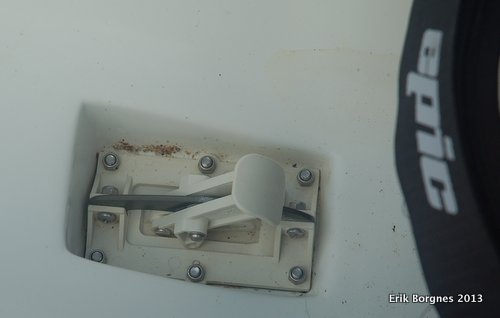
The new bailer
The bailer is the new Epic design and is an improvement over the Anderson mini that is on the V12. The new design is easily operated with your hand or foot. There are four positions: closed, open in position 1 which drains slowly but still empties the cockpit at speeds above 5.0 mph (8 kph), position 2 which drains very well, and position 3 which empties a full cockpit in just a few strokes. When the bailer is open in position 1, you feel a slight increase in drag on flat water and speed drops by about 0.1 mph (0.16 kph) or slightly less but you could still power up and get your speed back to where it had been when it was closed. Positions 2 and 3 create more drag and you definitely wouldn’t want to race continually with the bailer open in those positions. I find that on flat water I run the skis with the bailers completely closed or all the way open for just a few strokes to empty the footwell. On rough water, leaving it in position 1 is all you need to do to keep the footwell dry.
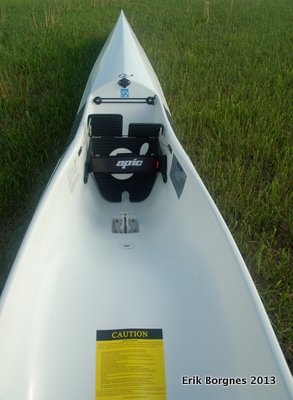
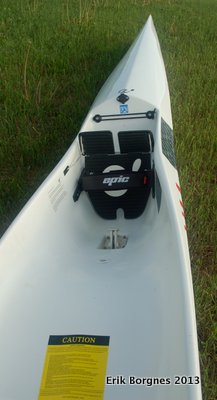
The paddler's viewpoint - and the "generous" paddle cut-outs
The paddle entry cutouts on the deck are generous. The bow is sharp and the hull is fairly rounded all the way to the tail. If you’re used to narrow catch skis then you’ll like these. No longer is the paddler staring at a bulbous V12 style bow nor a high old V10 bow. The new one is pointy and has a fairly standard shape.
Footplate - choices
New on this and other models is the choice of a standard length footplate or a long footplate. My size 45 (11.5) feet fit the long one just fine. The trick now will be for me to unlearn steering with the balls of my feet and learn to once again push with my whole foot and steer with my toes. So far, I find that while you’re paddling in a straight line and / or on flat water, I do feel the advantage of the full footboard to push on. On rough water, I am used to continually making steering adjustments to counter being slightly off balance and this I find this a bit less intuitive or slower to do with my toes as compared with the balls of my feet.
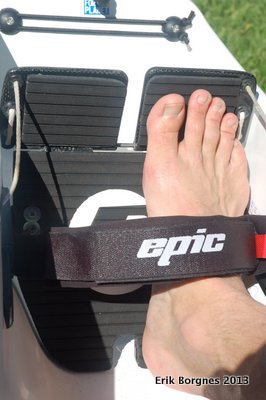
Long footplate for long feet!
Paddling the V14
So far, I’ve mostly had the V14 on flat water. First off, I didn’t notice the high seat position that I heard others rave about. It seems fairly standard and comfortable and far from the old sitting-in-a-bucket feel that we used to have to deal with. And, while some other elite skis use a flatter bottom for higher initial stability and more vertical sides for lesser secondary stability, i.e. a “U” hull cross-section, the V14 has more of a “V” cross section like an ICF K1. Underway, the ski feels very much like a K1 - but a long, heavy K1 that gives you just a little bit more time to react to tilting off center compared to a true K1. Initial stability is ok, nothing skittish, but secondary stability is . . . well, there’s not really anything there when you lean it over and if you try to wet the gunwale, you’ll swim. It’s definitely a ski that demands your attention.
I’ve spent most time with the Epic weedless rudder on, and on flat water, it’s surprising how responsive the ski is with that. With the universal rudder, it’s very controlled in rougher water.
On the single day that I paddled the V14 on 1-3 ft (1 m) wind waves, I found the ski to feel both narrow and again lacking in secondary stability. It did feel fast when going into the wind and downwind and GPS numbers confirmed this. While I can paddle this ski fairly well on rough water, I find that I’m brace-stroking too often and even though I suspect I’d be faster in this ski than in the V12 or the new V10, my gut tells me that it’s too much ski for me - and also that I’m not a spring chicken any more.
[Editor: I can confirm that for a 50 year old weekend warrior, the V14 is a twitchy beast. I paddled it in choppy water in Hong Kong last November, and I felt a bit of a fraud - as though I were driving a Ferrari with L plates in the back window. The ski felt fast - but at my level of competence the best I could say was that I didn't fall out!]
The new V10 - the people’s ski
The new V10, according to the computer model, has ever so slightly lower drag compared with the old V10. The difference being 1/10th of 1% lower drag. But, that measurement doesn’t include the bailers. On the old V10, the single large midline scupper is a permanent molding on the hull of the ski and induces drag. On the new V10 the bailer is retractable and this alone likely increases its speed by about 0.1 mph (0.16 kph) at race speeds.
![]()

The shape of the new V10 is similar to the V14. The bow is long and narrow on both the deck and the hull. The cockpit including the seat shape is much the same. The deck cutouts for paddle entry look similar as well, and the gunwales are low. Under water, the new V10 keeps a similar though slightly wider hull from the bow to the cockpit, aft of which, the new V10 flattens out into a shallow arch to the tail while the V14 keeps a rounded and narrower waterline. In fact, if you were sitting in the skis on the grass, you’d have to think for a bit which of the two skis you were sitting in. On the water, though, it’s a whole different story.
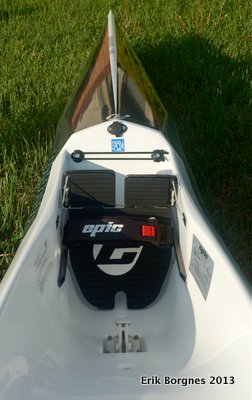
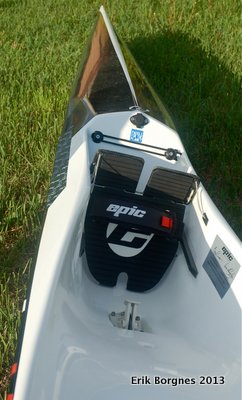
The new V10 cockpit and cutouts
Stable?
The V10 is stable. Stable “as the day is long” if you’re used to tippy elite level skis like I’ve become accustomed to. The obvious next thought is “hmm, this level of stability doesn’t come for free.” This must be an intermediate ski and slower than what I wanted.” Now, I’m not saying that this ski is beginner-stable nor is it really an all conditions intermediate ski like one might categorize the V10 Sport, Swordfish, Evo, etc. But, it’s awfully close. Still, it’s touted as an elite level ski. But, is it really?
On the water, the V10 has a subtle looseness in its primary stability. You feel right away that it’s quite stable, but at the same time, you also feel that the bottom isn’t flat. Lean it over and it just gets firmer and firmer way, way out there all the way until the gunwale hits the water which is far beyond where you’d expect it to go. Compared to the V12, which has low and loose primary stability but unexpectedly solid secondary stability, the primary stability on the new V10 is considerably better and the secondary stability comes in much sooner, is much firmer, and extends further out.
While underway, the V10 feels to have more drag than the V14. It doesn’t feel slow, but it doesn’t feel like a narrow waterline K1 the way that the V14 does. Like the V14, the new V10 is very responsive with even with the smaller weedless rudder.
On rough water, the V10 feels predictably stable and similar to how it feels on flat water. Going into 1-3 ft (1 m) wind, the bow slaps a little bit but no more than most other skis. It seems to ride flatter into the oncoming waves compared to the V12 but less so than the narrower waterline V14. Downwind, it’s a really fun boat to paddle because it paddles like it has very low rocker, so when it tips nose down, it just keeps on running with momentum as long as the pilot knows where to point it. I found that I had my paddle in my lap more than I usually do and when I wanted to jump onto a wave the extra stability allowed me to paddle far more aggressively than I otherwise would have. This is really a fun and confidence-inspiring ski to use.
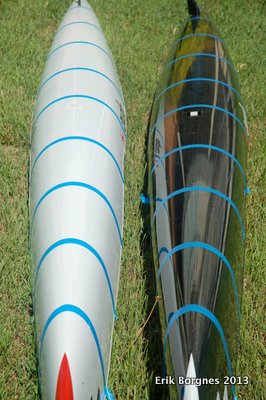
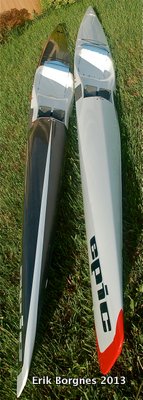
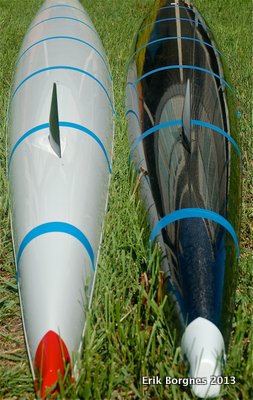
Speed Trials
First off, I’ll declare that I had no intention to back either horse in this race. Both skis are mine and I’m interested in accurate data as much as the next person is.
To compare the speed of different skis is a difficult thing to do. It’s hard to get objective data when you have to control for variables such as water depth, wind, current, and non-measurables such as motivation and restedness of the paddler. What I decided to do was to do back to back one mile (1.6 km) long intervals on the same stretch of a deep lake that was free from boat wake, current, waves. I used my heart rate monitor to get a semi-objective measurement of effort. I chose to do long intervals partly because the pace that one settles in to when you know beforehand that you’re going to do several of them, is about what one’s threshold or one hour race pace would be and that’s what I wanted to find out, i.e. in which ski would I be faster in a one to two hour race?
The other speed test that I did was to do multiple max effort sprints to see how high I could get the GPS speed. My thought was that this characteristic is important plus it would give information about the ski’s speed / resistance curve. However, not being a fast twitch guy or a real sprinter by any stretch of the imagination, there is always the possibility of me not being able to tease out the information on that curve, but I thought it was worth a go anyway.
I started with the new V10, took the speed up to about 8.4 mph (13.5 kph), waited for my heart rate to climb to the mid 160’s, then slowly backed off until I hit a steady state speed at heart rate of 169-170. I then made a mental note of what the average speed was during the final four minutes when I was at steady state and then wrote that number down. The first two intervals were done on the V10, the third and fourth on the V14, and then I did the fifth and sixth on the V10 again. The last two were to prove that the speeds were repeatable and that I didn’t tire and slow down during the V14 intervals.
In the V10, my first two intervals averaged 8.0 mph (12.9 kph). My speeds during the fifth and sixth were between 7.9 and 8.0 (12.8 - 12.9 kph), so pretty much the same speed at the same heart rate. In the V14, I only averaged 8.1 mph (13.1 kph). I say “only” because I was a bit surprised. The V14 feels like it’s got better glide, it feels like its waterline is much narrower. It feels faster.
For maximum speeds I again used a GPS. The display latency of the GPS seemed to be about 1 second. But, if you’re sprinting in a straight line, it’s accurate enough to measure and compare what I was wanting to compare, and after all, I was no more interested in the absolute peak speed as I was in the average peak that registered on the GPS - maybe the area under the curve sort of thing. With 20 attempts of a short max effort sprint on flat water starting from 6-7 mph (10-11.6 kph), I registered 9.7 mph (15.6 kph) several times in the V10 and 9.9 mph (15.9 kph) in the V14.
Conclusion
In the end, I came out more impressed with the new V10 even though the V14 is the flagship racehorse. The V10’s stability is way beyond what I would expect for its speed, and for a paddler like me, the huge margin of extra stability far outweighs the small loss in speed that I would get when using the V14 in most all circumstances. If my boat balance were poorer, there would be no question that the V10 would be the way to go. However, if I were faster, or if a high seat racing K1 were my main boat, or if my boat balance were exceptional, I’d probably choose the V14.
How do these skis compare to the V12? I’m very comfortable in the V12 since that’s been my only ski for the last three years. Predictably, the V12 feels smack dab right in the middle of both other skis in its stability and feeling of speed on flat water. All three skis seem to have about the same narrow catch, the same response from the rudder and the same ergonomics - save for the slightly more anatomic seat in the newer models. I suspect, though, that in short wavelength wind chop, the new V10 and V14 should be faster due to their narrower wave piercing bows.
How does the new V10 compare with the old V10? Joe Glickman has raced the older V10 for many years and has now switched to the new model. His comments:
“Having the techincal savvy of an English major who thinks a slide rule measures a baseball player stealing second base, my impressions are decidedly unscientific; however, my impressions of the new V10 jive with all that Erik penned above.
"The biggest difference between my old carbon V10 and my new V10 Ultra is the stability: the newer ski is far more forgiving to the extent that you assume the boat must be slower. It is not. While the retractable bailer reduces drag -- a factor that is more noticeable on flat water -- I've found that I'm able to work harder, more often and longer in choppier, more dynamic water.
"No matter the comparative differential in the hull speed, the fact remains: miss a stroke or two in a 'faster' boat and you're significantly slower. Combine the fact that the new V10 feels easily as fast as the old model and you have a wining combination.”
And then there’s: when racing an old V10, or any other similar ski with an open venturi, with the new V10, V12, V14, the paddler is able to close the bailer and eliminate its drag -- sort of a “level 11” so to speak, as in the volume control knob made famous in the movie “This is Spinal Tap.”
...that black kayak sure is a fast one
True story: While doing my 1 mile (1.6 km) intervals with the skis on little Lake Emily, I kept passing and politely trading nods with an older fisherman in a small boat who had a belly the size of a keg and a T-shirt that just didn’t quite reach down to his navel - you know the guy. He came up to me after I had finished and after some small talk said, “Yup, that black kayak is sure a fast one.” I told him what I was up to and said that, as a matter of fact, the white one was faster. He didn’t buy it. “Oooh no. No way. That black one hardly had any wake behind it. The white one was bobbin’ a bit. That black one’s gotta be faster.” I showed him that I had been using a GPS monitor and stated again that I was noting the speeds and the white one was just a hair faster. He shook his head, mumbled something, and walked off towards his truck with his fishing pole in one hand and his keys in the other.
My vote - go for the V10 . . .and in black, because black is faster.

